In this section, you will learn about the political parties of the early republic and the emergence of a new political party system. You may already be familiar with modern-day political parties such as the Democratic, Republican, Libertarian, and Green Parties. In today’s political party system, people have the choice to follow the party that best fits their personal and political beliefs. The political parties of the early years of the republic were characterized by sectionalism. The Federalist Party dominated the Northeastern states, and the Democratic-Republican Party dominated most other states.
After the War of 1812, the country saw a change in the political parties. Membership in the Federalist Party began to decline. The opposing party, the Democratic-Republicans, then began to break into factions. The disruptions within the Federalist and Democratic-Republican parties led to a new political party system. There are three factors that contributed to the creation of the second party system. Click on each of the three factors to learn more.
![]()
The election of Andrew Jackson brought with it a new approach to political parties. Jackson first ran for president in the 1824 election. There were three other candidates running for president, but Jackson won more electoral votes than the other three candidates.
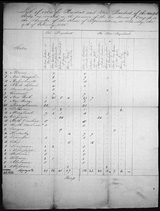
Source: Tally 1824, National Archives. The 1824 Electoral Tally Sheet |
Did you know - The Electoral College was established by the founding fathers as a compromise between election of the president by Congress and election by popular vote. The people of the United States vote for electors who then vote for the President. |
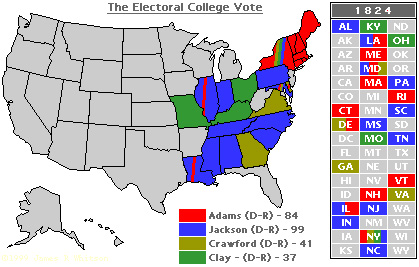
Source: The Electoral College Vote of 1824, Vote, President Elect
Because he didn’t win the majority (more than half) of the votes, the vote went to the House of Representatives who selected as the sixth President of the United States.
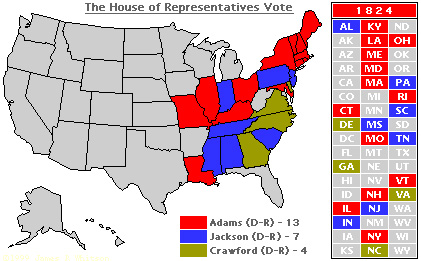
Source: The House of Representatives Vote of 1824, President elect
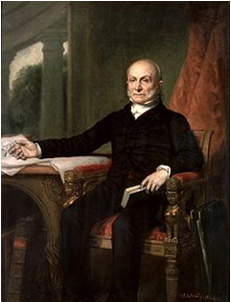
Source: John Quincy Adams,
George Peter Alexander Healy, Wikipedia.
Quick Thought – Do you think this method of electing the president was fair? Should Jackson have been elected since he won the most electoral votes? How do you think most Americans responded to this election?
As a result of this election, the politics of America began to change drastically. States began to change or eliminate the property and tax qualifications to vote or hold a public office. There were also changes in the method of elections. Selection by state legislature was slowly being eliminated.
These and other political changes transformed voter participation from wealthy, land-owning adult white males to a wider group of voters.
Do you believe these changes increased or decreased voter participation in public elections? (Click on the correct answer.)
Interactive popup. Assistance may be required. Correct! More citizens began to participate in the voting process since barriers to voting were beginning to be removed. Interactive popup. Assistance may be required.
Try again. Removing the barriers to vote increased voter participation.
Interactive popup. Assistance may be required.
Try again. Removing the barriers to vote increased voter participation. 
Because of increased voter participation, there was renewed interest in politics. By the mid-1830s, two major political parties had emerged. The Democratic and Republican (Whig) parties became popular, giving birth to the modern political system.
During the time Jackson campaigned for president in the 1828 election, there was more political participation by ordinary citizens. Jackson’s campaign was the first to use a political organization to appeal directly to the voters for their support. Twice as many voters cast ballots in this election as in 1824, and four times as many as in the 1820 election.
The final votes reflected the lines of sectionalism. Jackson won the states of the South and the West, while Adams won most states in the North.
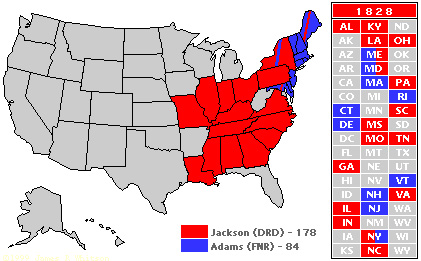
Source: President-elect.org
The election of Andrew Jackson served as a victory for democracy. His supporters saw it as a victory for the common man - the farmers and workers of America - over the rich and elite.